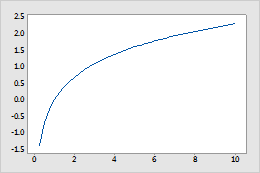To use this function, choose .
Calculates logarithms to the base e, where e is the constant equal to approximately 2.71828. The natural log of any positive number, n, is the exponent, x, to which e must be raised so that ex = n. For example, e2 = 7.389, so the natural log of 7.389 is 2.
The following graph represents the natural log function.

Syntax
LN(number)
In number, specify the value or column of values. Minitab calculates the value x such that ex = the number. If you enter 0 or a negative number, Minitab stores a missing value symbol *.
Example
| Calculator expression | Result |
|---|---|
| LN(7.38905) | 2 |
Uses
The function of the natural log has many applications, such as modeling exponential growth in biological populations and in financial theory, and calculating radioactive decay.
- To make moderately skewed data more normally distributed or to achieve constant variance
- To allow data that fall in a curved pattern to be modeled using a straight line (simple linear regression)
- To stabilize variation when estimating standard deviations (Z-MR control chart)
- To analyze variability in response data for experiments that include repeat or replicate measurements (factorial design)
The natural log is also used in the calculation of probability density functions for many distributions.
